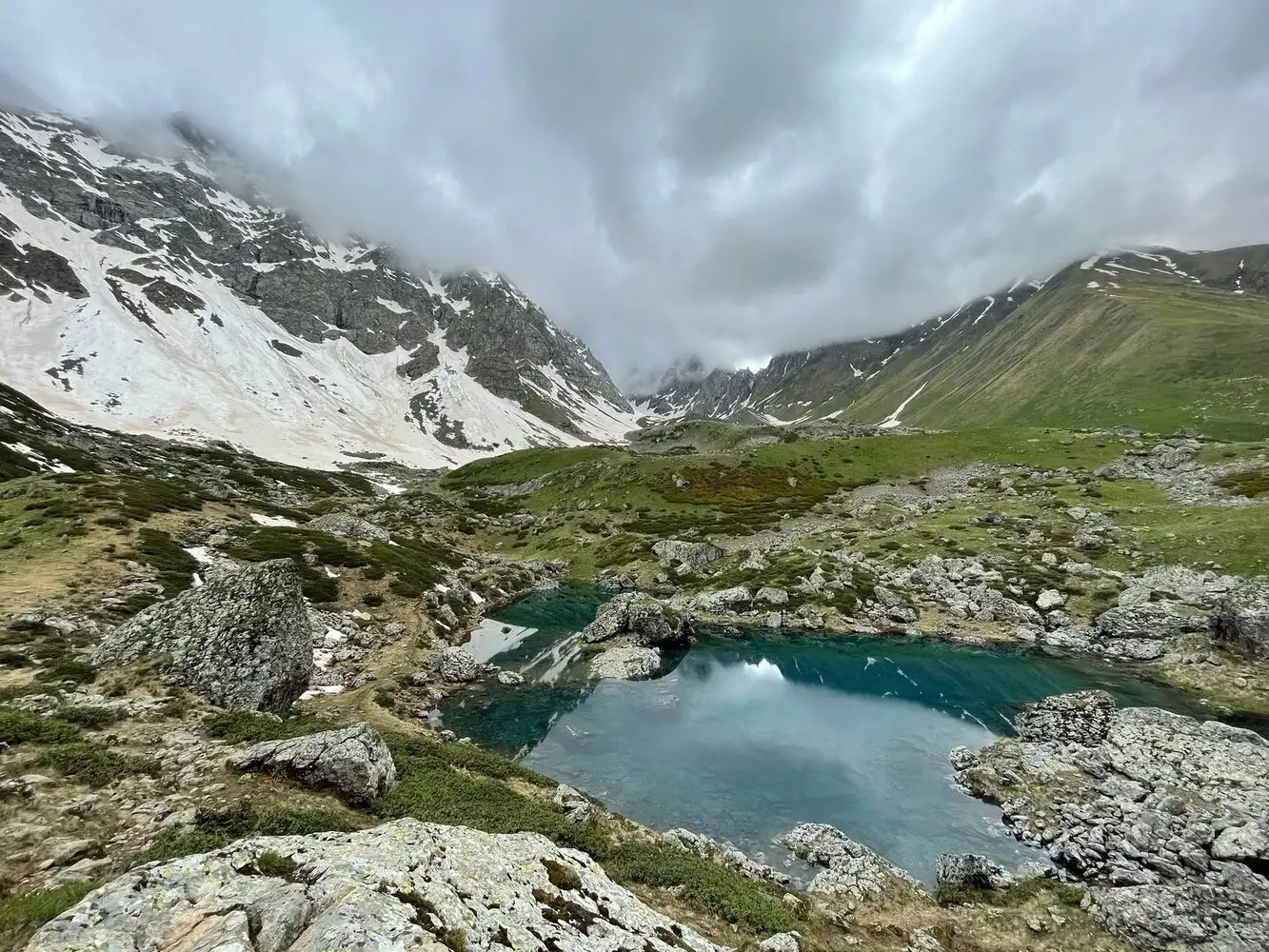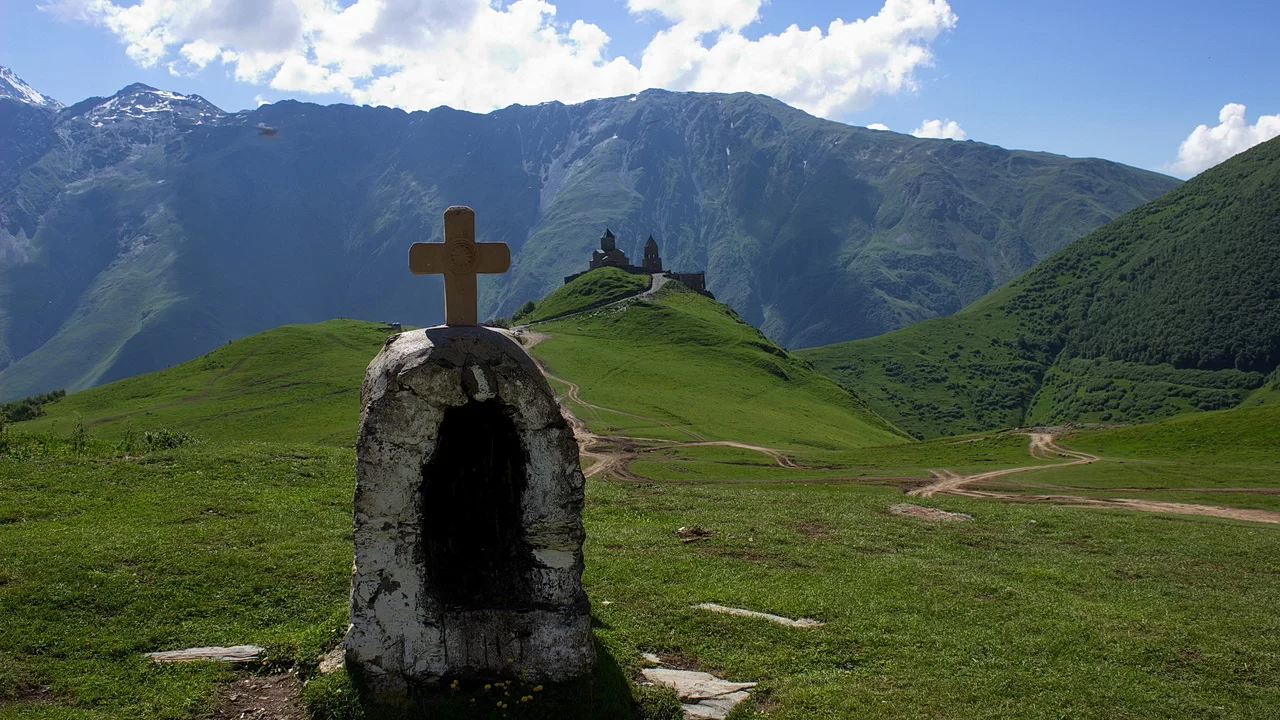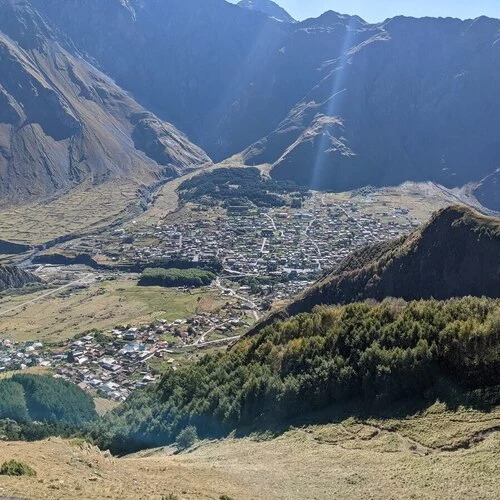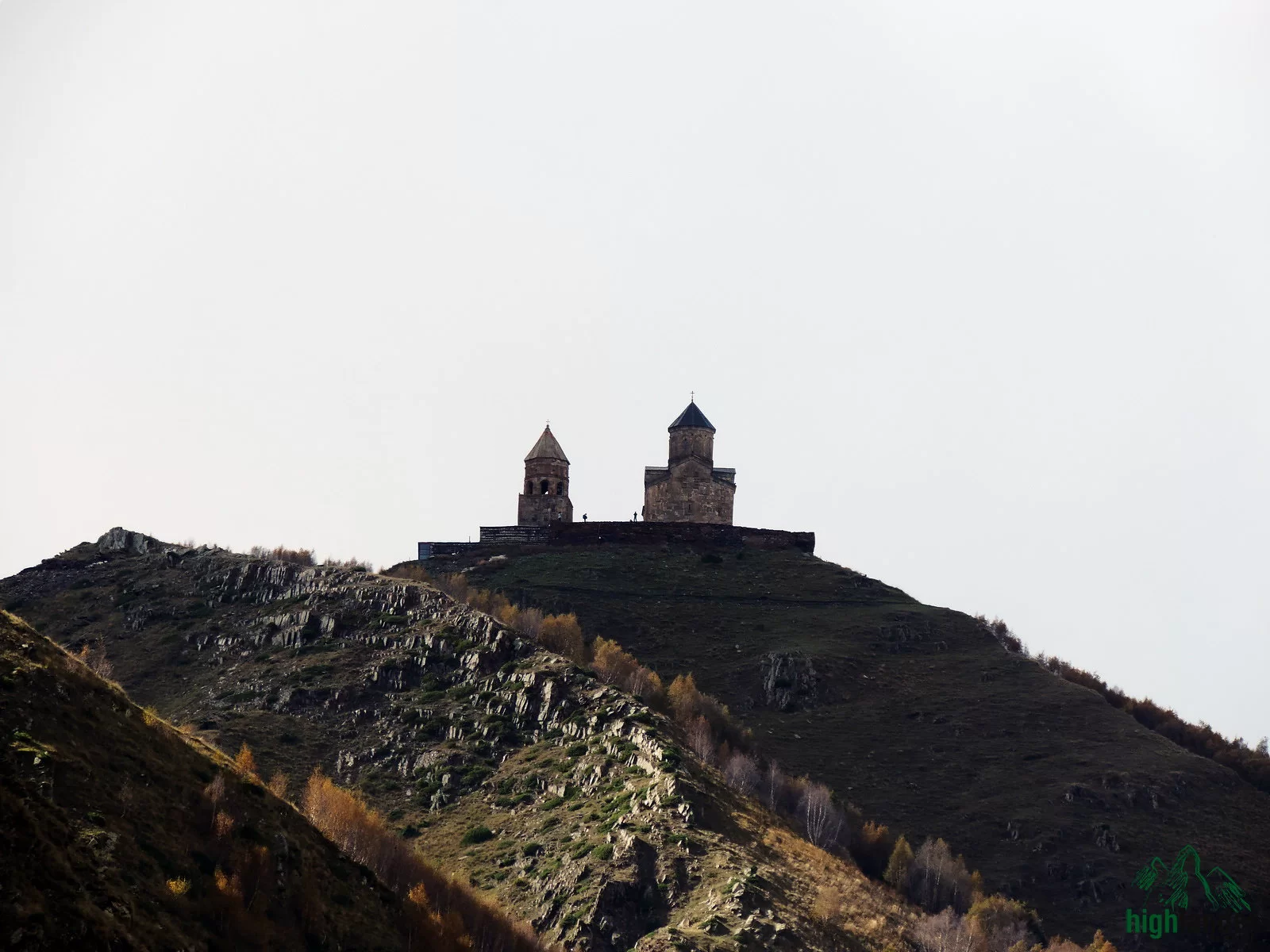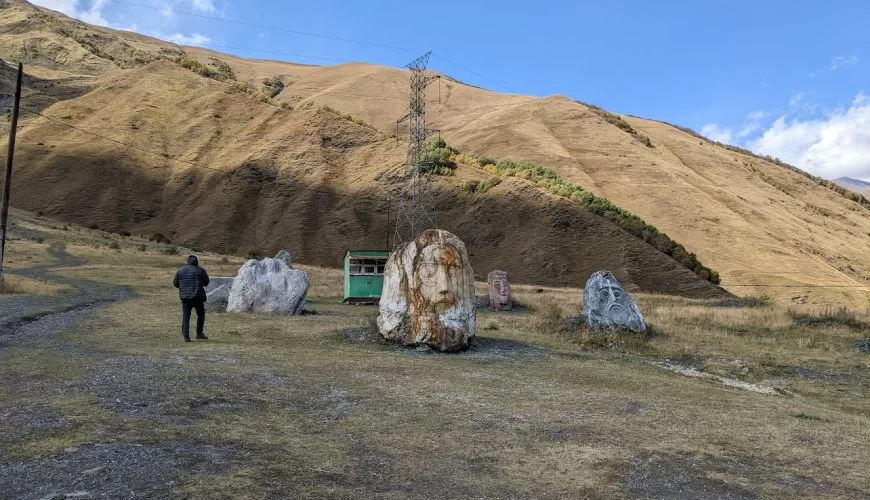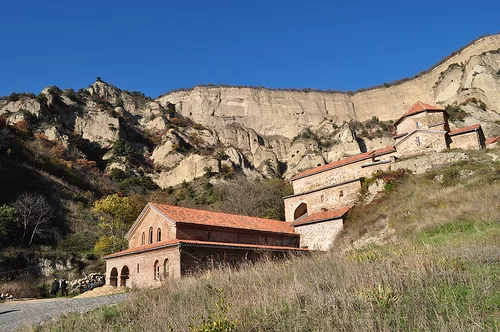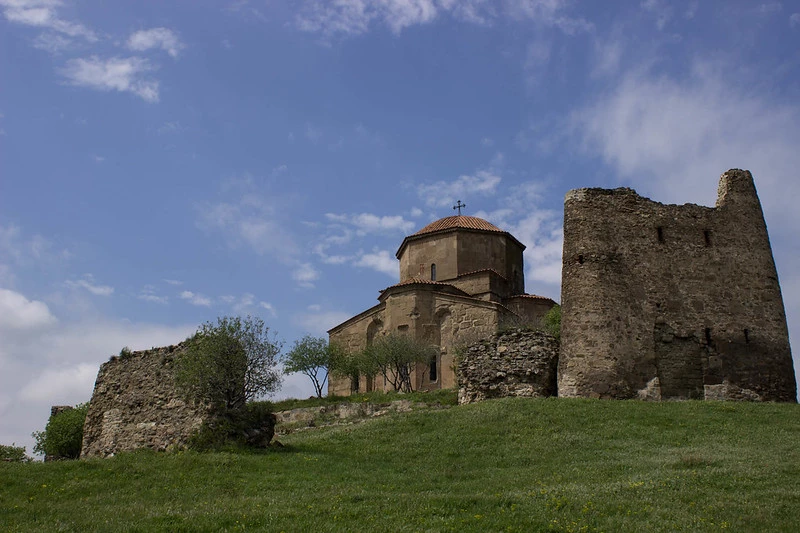Mtskheta-Mtianeti
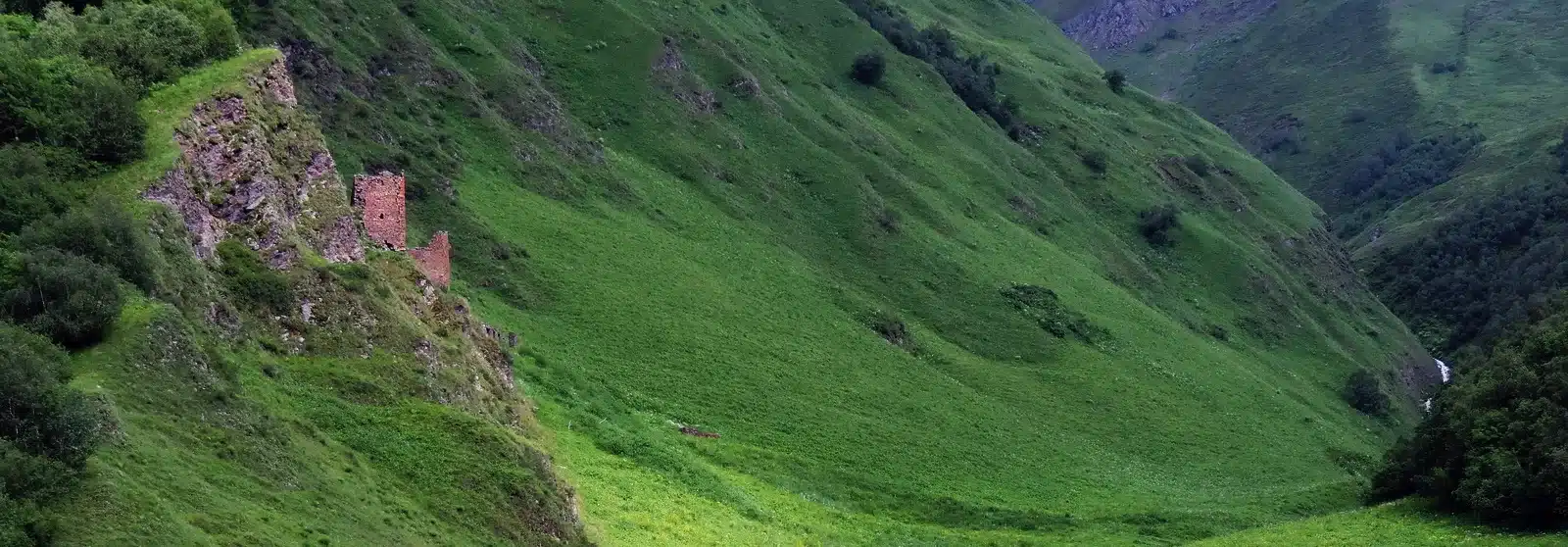
Mtskheta-Mtianeti: Where Ancient Capitals Meet Mountain Giants
The region where Georgia’s soul was forged—UNESCO churches, the iconic Kazbegi peak, medieval fortresses, and mountain villages that time forgot
If Georgia has a greatest hits album, half the tracks come from Mtskheta-Mtianeti.
This is where Christianity first took root in the Caucasus. The Georgian Military Road carves through some of the most dramatic mountain scenery you’ll ever see. Where Gergeti Trinity Church perches impossibly on a mountainside with 5,047-meter Mount Kazbegi looming behind it—the postcard shot that launched a thousand Instagram accounts.
But Mtskheta-Mtianeti is more than just Kazbegi. The ancient capital of Mtskheta is home to UNESCO World Heritage-listed monasteries that are over 1,700 years old. Ananuri Fortress stands guard over a turquoise reservoir. Gudauri offers some of Europe’s cheapest and most underrated skiing. And in the far reaches of Khevsureti, medieval stone villages cling to mountainsides where locals still remember pagan gods alongside Christian saints.
This region stretches from Tbilisi’s doorstep to the Russian border, from easy day trips to multi-day wilderness treks. Whether you have two days or two weeks, Mtskheta-Mtianeti delivers Georgia at its most photogenic, spiritual, and adventurous.
Mtskheta-Mtianeti is a mix of several historical parts, like Khevsureti, Khevi, Aragvi gorge, Gudamakari, Ksani gorge, etc.
Why Visit Mtskheta-Mtianeti?
Because this is Georgia’s most accessible adventure.
You can see UNESCO World Heritage sites in the morning and be hiking beneath 5,000-meter peaks by afternoon. You can explore a 6th-century monastery, then ski fresh powder. You can photograph one of the world’s most iconic mountain churches, then soak in natural hot springs.
Here’s what makes this region unmissable:
The views are absurd. The Georgian Military Road, one of the world’s great mountain highways, winds through this region. Around every hairpin turn: snow-capped peaks, rushing rivers, and valleys that drop away into nothing. Gergeti Trinity Church with Mount Kazbegi behind it is probably the single most photographed sight in Georgia. And for good reason – it’s stunning.
History goes deep. Mtskheta was Georgia’s capital when Rome still ruled Europe. The Christianity that defines Georgian identity today was born here in 337 AD. Two UNESCO monasteries—Jvari and Svetitskhoveli—stand as a testament to Georgia’s golden age. Standing in Svetitskhoveli, where Georgian kings are buried, you’re literally touching the foundation of the nation.
The mountains are world-class. Mount Kazbegi (locals call it Mkinvartsveri) dominates the skyline at 5,047 meters. It’s one of the major peaks of the Caucasus and a serious mountaineering objective. But you don’t need to be a climber to enjoy it—hiking to Gergeti Trinity Church or trekking in the valleys gives you those epic mountain views without technical skills.
Adventure is everywhere. Gudauri offers incredible skiing at a fraction of Alpine prices (day pass: €25-35). White-water rafting on the Aragvi River gets your adrenaline pumping. Paragliding off the mountains gives you a bird’s-eye view of the Caucasus. Multi-day treks through Khevsureti take you to medieval villages where time genuinely stopped.
It’s incredibly accessible. Mtskheta is 20 minutes from Tbilisi. Kazbegi is a comfortable 3-hour drive. Even the “remote” areas like Gudauri are on paved roads. You can do day trips or base yourself in Stepantsminda for a week of exploration. No complicated logistics required.
The food and culture are authentic. This isn’t a tourist theme park. Villages along the Georgian Military Road have been here for centuries. Shepherds still drive flocks along ancient routes. Family guesthouses serve home-cooked khinkali (the dumpling was invented in these mountains). You’ll eat food made by grandmothers who learned the recipes from their grandmothers.
The diversity is incredible. In one region, you get: ancient religious sites, Soviet ski resorts, medieval fortresses, alpine lakes, hot springs, glacier views, and some of the most remote villages in the Caucasus. Whether you’re into history, nature, adventure, or photography, Mtskheta-Mtianeti delivers.
Historical parts of Mtskheta-Mtianeti
Mtiuleti
Highland region in east Georgia. Bordered by Khevi and the Great Caucasus range from the north, Lomisa range from the west, Gudamakari from the east, and Kartli from the south. The province is located in White Aragvi’s gorge. Via Mtiuleti is going historical road, which connects central Georgia with the North Caucasus, later known as the Georgian Military Road, so the region was much less isolated than other highland regions. The most notable place of interest here is the Ananuri complex, located on the bank of the river Aragvi. Also popular here is Rafting. The main holy place for local people is Lomisa church, which is located at the top of the Lomisa range. Here, earlier, was a pagan holy place.
Gudamakari
The historical province of East Georgia. Located in the gorge of Gudamakari Aragvi. Surrounded by the Great Caucasus range from the north, the Gudamakari range from the west. Gorge isn’t a popular tourist destination, but from here can be arranged trekking tours to Khevi province.
Pshavi
Pshavi is one of the historical provinces of Georgia, in the modern Mtskheta-Mtianeti region. In the early Middle Ages, it was called Pkhovi, together with Khevsureti. From the north, Pshavi is bordered by the great Caucasus range, from the west – Khevsureti and Gudamakari, from the south – Shida Kartli, and Tianeti from the east. Pshavi is divided into two communities – Ukana Pshavi and Magaroskari. People of Pshavi–Pkhovi are first mentioned in early historical sources, that they were refused to adopt Christianity, and because of this had a serious conflict with the central government. Christianity in Pshavi was adopted later than in lowland Georgia, only around the XII century. Also in this period, the people of Pkhovi were divided into Pshavians and Khevsurians, who remained pagan. But nowadays, there are still strong old pagan beliefs. Later, when Georgia was divided into many little kingdoms, Pshavi was part of the Kakheti kingdom. The most well-known person from Pshavi was the famous Georgian poet Vaja-Pshavela (1861-1915). In his native village, Chargali, every year is a folk festival in his honor. For tourists, Pshavi is also interesting because of rafting on the river Pshavi Aragvi, which is the province’s main river.
Khevsureti
One of the most interesting provinces in the region is Khevsureti, part of the former Pkhovi. Khevsureti is divided into three parts: Aragvi gorge on the south slopes of the Great Caucasus range, Argun and Assa gorges on the north slopes of the Caucasus range. From the north, Khevsureti is bordered by Chechnia and Ingusheti, from the east – Tusheti and Atsunta range, from the south – Pshavi and Gudamakari, and from the west Khevi and Mtiuleti. Christianity in Khevsureti was adopted during the late Middle Ages, but till nowadays, pagan beliefs here are very strong, even much stronger than in neighboring Pshavi and Mtiuleti. The region always was, and still is, very isolated, that’s why there survived many old traditions, architecture, etc. and this attracts many tourists. The most popular tourist destination here is Argun gorge, which is located village of Shatili. The only road here goes via the Datvijvari pass, which is closed from October to June, so the area is accessible by car only during the summer. Other places of interest here are the villages of Mutso, Ardoti, and Khakhabo, where medieval fortification architecture survived very well. More isolated than Argun gorge is the river Assa gorge, which is located third part of Khevsureti – Arkhoti. Here isn’t a car road and the only way to come here is by trekking. Besides cultural tours to Shatili and Mutso, very popular is traveling in Khevsureti. Tourists are attracted here by the authenticity of the area, wild, untouched nature, and high mountains.
Khevi
Located on the north slopes of the Great Caucasus range, consists of Tergi gorge, Truso gorge, Sno gorge, and Dariali gorge. Here goes the Georgian military road, and unlike Khevsureti isn’t so wild and isolated. The road to Khevi goes via Jvari pass, which is rarely closed during wintertime. The center of the area is the town of Stepantsminda. Khevi is bordered by Khevsureti from the east, North Ossetia from the north and west, and Mtiuleti and Ksani gorge from the south. Khevi – also known as Kazbegi- attracts many tourists, first of all, it is close to Tbilisi, only 3 hours of driving, also there are many popular hiking destinations; from here, it is also possible to hike to the Khevsureti area. Mountain climbers are attracted by the mountain Kazbegi (5021m). Currently big part of the area belongs to Kazbegi national park.
Tours in Mtskheta-Mtianeti
Why Mtskheta-Mtianeti Is Essential
Every Georgia itinerary includes Mtskheta-Mtianeti for good reason. This is where you’ll find the images that made you want to visit Georgia in the first place.
But it’s more than just pretty pictures. It’s where you’ll understand why Christianity matters so much to Georgian identity. Where you’ll see mountains that make you feel genuinely small. Where you’ll eat khinkali made by the great-great-grandmothers who invented them. Where you’ll stay in medieval towers that are still inhabited 700 years after they were built.
Is Gergeti Church crowded? Yes, at midday in July. But hike up at dawn and you’ll stand alone in alpine silence with a 5,000-meter peak glowing pink in the sunrise. That moment—that’s why you came.
Is Mtskheta touristy? Sure. But stand in Svetitskhoveli Cathedral where Georgian kings are buried and you’re touching 1,700 years of continuous history. That matters.
Is the road to Shatili terrifying? Absolutely. But when you arrive and see those medieval towers rising from the valley, you’ll understand why it had to be this remote.
Mtskheta-Mtianeti is accessible enough for anyone, wild enough for adventurers, historic enough for culture vultures, and beautiful enough to make you cry. That’s a rare combination.
- Mtskheta
- Basaleti
- Gudauri
- Stepantsminda
- Shatili
- Chargali
- Juta
- Ardoti
- Akhieli
- Kazbegi mountain
- Dariali gorge
- Cross pass
- Datvijvari pass
- Assa gorge
- Chiukhi mountains
- Tebulo mountain
- Argun gorge
- Gveleti waterfalls
- Truso gorge
- Kazbegi national park



